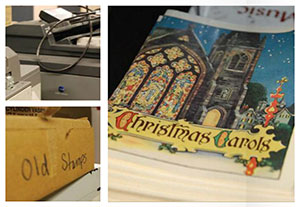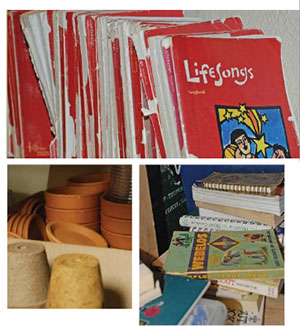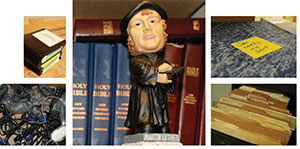Photos by Kathryn Brewer
These are just a few of the things readers found when cleaning out church cupboards and closets, basements and attics:
- Mimeograph supplies.
- A poker table.
- A Sunday school Christmas program from 1942.
- Chicken incubator lights.
- And, wait for it … chickens — live ones.

As a nod to the new year, The Lutheran posted a reader call that asked, “What does your congregation need to toss (literally and figuratively)? Old hymnals or old attitudes? Felt boards or outdated programs? What have you cleaned out that caused both a chuckle and relief?”
Few people offered up attitudes or programs they’d like to get rid of. But plenty of folks have cleaned out hymnals and felt boards. Clearly, emptying the storage bowels of church buildings caused both a chuckle and relief. And much more.
Pam Raynor Warnor, St. Mark Lutheran Church, Mayville, N.Y., found the 1942 program while desperately searching for anything she could use this Christmas season. Something from more than seven decades ago wasn’t what she had been hoping for.
But Lauren Ashley, Nativity Evangelical Lutheran Church, East Brunswick, N.J., did make a Christmas find worth keeping: “I found Christmas cards we used to cut up and make new cards for the homebound. In them was a card from my grandpop from 1993, his last Christmas with us. That card has been sitting there about 20 years just waiting for me to clean up the church.”

And then there were chickens …
Stephanie Quick Espinoza, St. Stephen Lutheran Church, West St. Paul, Minn., was a missionary in Costa Rica when she had to clean out the chickens that were laying eggs in the sacristy/storage closet.
Another person on Facebook was curious enough to ask what she did with them. “I put them outside and then they got through a broken window again,” Espinoza responded. “So I fixed that and they finally stayed out.”
In an unrelated response, Arianna Hilsen Arends of St. Paul, a joint United Church of Christ and ELCA congregation in Lewiston, Minn., said chicken incubator lights were the weirdest thing she found during the last church cleanout.

Hymnals and robes, oh my!
“Probably get rid of the black hymnals,” suggested Rico Ludovici on Facebook. “You know, the ones from before the mythic red hymnal.”
Hymnals and choir robes were often addressed in a cleaning project.
“Definitely keep several of each previous hymnal,” offered Jim Wattrick, Christ the King Lutheran Church, West Chester, Ohio. “The oldies are goodies. I miss the prior red hymnal.”
Tucker James Nelson, Our Savior Lutheran Church, Virginia, Minn., cautioned against throwing out a heap of hymnals: “I think churches need to have organized archives, which should involve keeping at least one copy of old hymnals. It’s important to see how the faith has progressed and changed.”
Reader Marilynne Smith, First Lutheran Church, San Diego, suggested giving hymnals away to people who want a copy for home.
Nancy Roper Bickley, Martinez, Ga., was one who ventured into less literal territory: “I’d like to keep the old hymns.”
Audrey Seaberg, St. Paul Lutheran Church, Quincy, Wash., took advantage of the Facebook post to say her church is currently looking for a home for purple choir robes. Troy Olson, ministry associate at Luther Crest Bible Camp, Alexandria, Minn., suggested she donate them to the props closet at a nearby camp.
Olson also offered an attitude that should be pitched: “The idea that ‘children are our future.’ They’re here and now, just like you and me.”
And those youth need a decent place to sit. Juli Lejman-Guy, St. John Evangelical Lutheran, Bellevue, Ohio, said her congregation needs to “get rid of all the old couches with no springs or padding left in the outdated ‘youth’ room to make room for today’s youth.”

Time marches on
Cleaning out storage areas gives leaders a chance to marvel at the advances in technology — and mourn that filmstrips are still in the cabinets.
In addition to filmstrips and a projector, Calvary Lutheran, Two Rivers, Wis., during renovation found in the church attic cassettes and vinyl LPs “that have the ‘ding’ when you’re supposed to change to the next side, Kay Richter said.
Several folks said they found and threw away an array of videos, as well as “millions of foam craft kits,” Concordia hymnals, 10 years of vacation Bible school kits in their original boxes, John Ylvisaker’s “contemporary” liturgies from the 1970s, Lutheran-Episcopal dialogues, an apron with pockets on every inch of it — filled with toys and treats, and a black and white film about Martin Luther on huge film reels.

Karyn Aarthun Ervin, St. John Lutheran Church, Riverton, Wyo., was the one who found a poker table in the storage closet: “No one knew how it got there.”
Although Paul Simmons, Saron Lutheran Church in Ashland, Wis., was willing to throw out the videos he found of “talking head lectures” from the 1970s, he said he wouldn’t throw out the felt boards. “They’re sentimental favorites” and can be used “when the video stuff won’t work,” he said.
One pastor said someone passing through town “asked longingly if we still had the felt board her mother had made. My secret heartfelt thought was, ‘Oh, I hope not.’”
St. Andrew Lutheran Church, Lake Worth, Fla., declared: “We could open an antique store!”
Pat Radd of of Nelsonville (Wis.) Evangelical Lutheran Church, one half of the Tomorrow River Parish, found spackle pots used for making egg coffee years ago. Her find resulted in a Facebook teaching moment regarding egg coffee — how to make it and how in some congregations only certain people had that job.
Carla Thompson Powell, United in Faith Lutheran Church, Chicago, said, “If books have a copyright date before my birth year I look very skeptically at them, especially if they are about ‘contemporary worship’ or youth ministry. … If brochures have copyright dates after 1980 but before 2005, they better have amazing content to earn their place in the brochure rack.”
Maretta Hershberger offered what may be a cautionary tale for pastors, church secretaries and Sunday school superintendents everywhere: don’t leave your stuff for someone else.
As a new secretary of Good Shepherd Lutheran Church, South Bend, Ind., she has the “dubious privilege” of cleaning the office of a pastor who retired two years ago: “On top of his desk, I found church bulletins from 1991. On the up side, I did enjoy his joke file. … Still, with my work about one-fourth finished, I have already carted out nine bags of trash, one of which was completely filled with old church supply catalogs.”
Freed to do God’s mission
Wayne Olsen, St. Paul Lutheran, Teaneck, N.J., wrote a spirited response just as his congregation celebrated its 90th anniversary. “It would probably take another 90 years for us to empty out our building,” he said.
“Beneath the dust bunnies, mold and mildew lie children’s games never opened and ‘Welcome to Our Neighborhood’ letters never sent. We have (no lie) 72 different keys for the building. We have 60 members today and 200 choir booklets from 1950. We keep them ‘just in case.’”
Acknowledging that it sounds like George Carlin’s “A Place for My Stuff” routine, he observed that church buildings become reliquaries for stuff and that council time and energy is filled with discussing upkeep and storage. He credits the current pastor with cleaning house and clearing the air, “freeing us to do God’s work.”
“Of course,” he added, “in our moments of clarity and lucidity, we hear God’s word and work to take care of the things that really matter. … If anybody reading this needs a Martin Luther Colorforms set, a 1939 filmstrip machine, an overhead projector, a lawnmower allegedly owned by [reformer Philipp] Melanchthon, and enough felt animals to fill 40 arks, give us a call.”
Members of United Lutheran Church in Oak Park, Ill., also found that cleaning out their building gave them a renewed sense of mission.
To maintain their aging building and serve the community, they needed to get more people through the doors, Sandy Williams said. That required shredding decades-old checks, recycling green hymnals and church directories, sifting through papers and ledgers from the Norwegian predecessor congregations, and throwing, among other things, broken toys from the nursery, an old folding machine and Sunday school books from long ago.
It was like an Easter egg hunt for those doing the work, she said, another egg in every opened cabinet. It caused gnashing of teeth from members, who wanted “things to be like the old days.”
“My reply is always that our church is like a large ship and it takes time to turn it around. And that’s what we’re doing,” Williams said.
Joy McDonald Coltvet was one of three staff members of Christ Lutheran Church on Capitol Hill, St. Paul, Minn., who spent an afternoon “cleaning house.”
Among the treasures: dog-eared copies of Good News for Modern Man version of the Bible, worn-out choir robes that had gathered dust for a decade, flower vases from years of funerals, the belongings of a homeless woman, and an artificial trellis left by a wedding party.
“With comments like ‘the church is not a junkyard,’ we boldly decided we could part with many things,” Coltvet said. “Perhaps we were inspired by Marie Kondo’s The Life-Changing Magic of Tidying Up or perhaps it was just time, but at the end of the day, shelves looked fresher and spaces looked clean.”
There is still more to do, she said, but it was the step they needed to take “to help our space feel more alive, open, joy-filled and ready to receive whatever comes next in our collective story. Thanks be to God.”
Tom Pairan, Nazareth Lutheran Church, Chatfield, Ohio, also felt a sense of victory: “I found the Ark of the Covenant in the church basement, probably from a vacation Bible school drama. It made me feel like Indiana Jones.”




